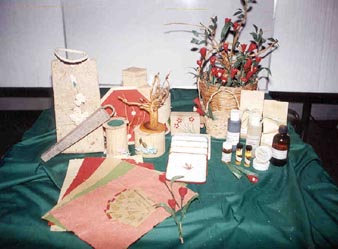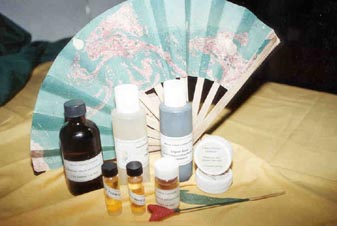Other Uses
Medicinal & Veterinary Product Development
Tobacco has always been considered as a medicinal plant. Before its use as a smoking material, it has been used as a traditional medicine for common illnesses. It is claimed to be an antiseptic, sedative, emetic, purgative and useful in relieving pain. In recent years, nicotine has been recommended for hypodermic injections in tetanus and strychnine poisoning. The plant is also used as a source of isoprene units required for the production of a cardiac drug UQ-10. For veterinary applications, tobacco was found useful as an antiseptic for cleaning wounds. It is also suspected to have anti-coccidial properties in poultry. |
Our current efforts at NTA involve studies on the phytochemistry, antimicrobial activitiy and pharmacological properties of tobacco. Our initial results indicate the high inhibitory effects of tobacco ethanolic extracts to the growth of Az. brasilense, M. lutens, S. aureus, B. cereus, B. polymyxa, and P. fluorescens. The growth of E. coli, B. subtilis, P. aeruginosa, S. typhimurium, K. pneumoniae and E. cloacae were also inhibited. Tobacco-based ointments and liniments are also being evaluated. |
By-Products & Waste Utilization
The stalks, top leaves, stem, scraps and dusts are tobacco wastes which can be utilized as sources of nicotine and nutrients. Being biodegradable, they are particularly appealing alternatives to synthetic pesticides and fertilizers especially during these times of high level consciousness for "environment-friendly" technologies, and the fact that synthetic fertilizers and pesticides are very expensive.Our Crop Protection group found that tobacco scraps and waste products applied at 200 kg/ha cab effectively control the pest golden kuhol in rice fields. This practice also increased the yield.
Tobacco aqueous spray (1:10 tobacco:water ratio) and tobacco dust were also found effective as pesticides. Tobacco spray applied at 10-days interval can reduce the population of beanfly and bean aphids by 89% and 97%, respectively. Tobacco dust, on the other hand, can effect 80 to 90% kill on tomato cutworm and beanfly, respectively. Leafhoppers, thrips and corn earthworm can also be controlled using either tobacco spray or dust. Tobacco stalks and midribs were already proven to be excellent media for mushroom culture. This technology is already commercialized.
Food & Feed Products Development
Tobacco can be a source of food and feeds. A very high quality protein (called fraction-1 protein) can be extracted from its leaves for human consumption. The seeds are free from nicotine and are rich in protein (25%) and oil (35%). As such, they are good sources of edible and industrial-type oils. The seed cake obtained after the extraction of the oil serves as protein-rich feed for cattle and horses.For crop year 1992-1993, we were able to make pastry products like polvoron, pastillas, cookies, doughnuts and pancakes with ground tobacco seeds substituting for up to 30% of the flour requirements. Tobacco seeds can also substitute for sesame seeds or peanuts in brittle candies. Taste tests conducted on elementary pupils, high school students, college students, and professionals showed the high acceptability of these products with ratings of "liked" to "liked a lot" using the Smiley Test.
As feeds tobacco seeds can substitute for 25% of the commercial feed ingredients for broilers. Our initial findings on tilapia revealed that up to 70% of their feeds could be substituted with tobacco seeds.
Our future activities include the extraction, purification and conversion of the tobacco leaf protein (fraction1-protein) into familiar food items such as cheese, gelatin, nutri-crunch (kropeck) and as major component of beverages.
The potentials of tobacco as source of food and feeds are, therefore, very promising. If fully tapped, it will not extend the usefulness of tobacco but more importantly, will be a positive factor on easing the increasing demand for food.
Wood, Pulp & Fiber Product Development
 |
The development of wood, pulp and fiber products from tobacco is very timely both from the viewpoints of environmental conservation and promotion of tobacco as a cheap and readily available supply of raw material for industrialization. Tobacco stalks are woody and pliable while the midribs are pulpy. As such, they are suitable for the manufacture of particleboard, paper, handicraft, and pulp. Being able to produce matured stalks within six months, tobacco also has the distinct advantage over the traditionally used tree species, which require about five years to become economically important. |
We were able to manufacture homogeneous and three-layered types of particleboards from tobacco stalks. Both passed the standards set for commercial-type particleboards. These can be used as low cost boards for mass housing.
Other products that we developed include handmade paper and paper products from stalks and leaf midribs (in cooperation with the Duntog Foundation) and different kinds of handicrafts such as wall dividers, baskets, handfans, wall decors, etc. The handicrafts rival the beauty of bamboo or rattan.
The Future
 |
Tobacco has been cultivated mainly for its leaves. The very high economic returns from the leaves favored this practice, hence, neglecting the potentials of the other parts of the plant. However, with the current emphasis on the development of other products from tobacco and with the very encouraging results that we are getting, the NTA is confident of doing its share in promoting the industrialization of the countryside. In the words of former Administrator, Joaquin T. Ortega, " . . . the tobacco industry is beset with problems now, but with the development of other tobacco products, tobacco may still prove to be the crop of the future." |




